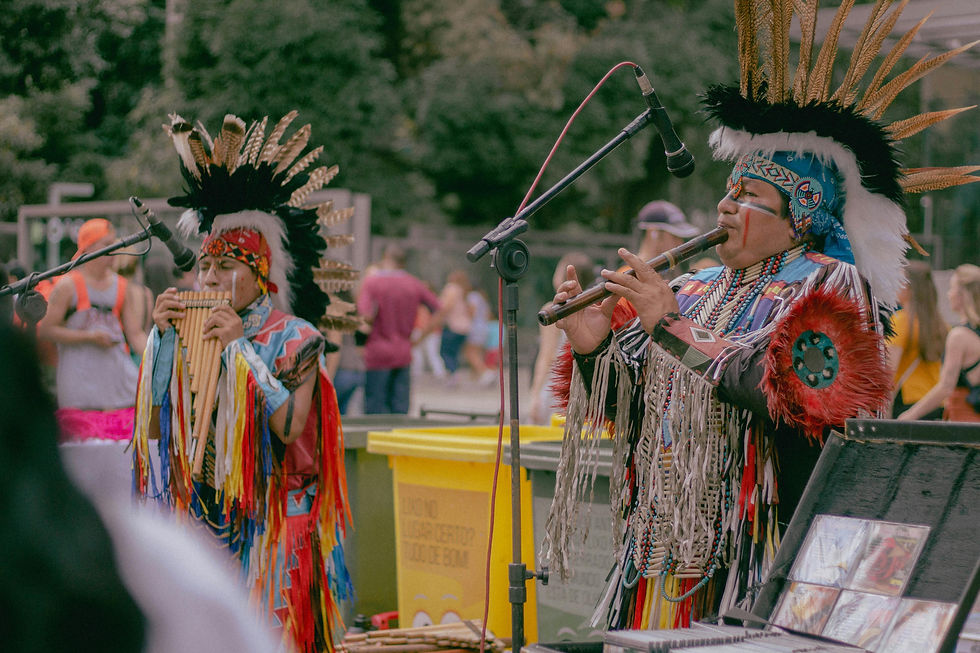Ancestral Sound Baths: Global Healing Traditions Behind Today’s Wellness Trend
- Dr. K.

- 1 day ago
- 4 min read
Walk into a yoga studio in Los Angeles, a resort spa in Bali, or a wellness retreat in Arizona, and chances are you’ll see “sound bath” on the schedule. It’s marketed as a stress release, an hour of crystal bowls or gongs that wash over the body. But despite the marketing buzz, the idea isn’t new. Across cultures and centuries, humans have turned to sound—through instruments, chants, or rhythm—to shift mood, ease pain, and connect to something larger.
Sound baths may feel modern, even Instagram-ready, but they carry an older lineage: ancestral healing practices that have long used vibration, tone, and resonance as medicine.
What Is a Sound Bath?

The modern definition is simple: a meditative practice where participants are “bathed” in sound waves, usually from bowls, gongs, or chimes. In the U.S., they’ve moved beyond yoga studios—gyms, corporate wellness programs, and even boutique sound studios now offer weekly sessions. Resorts add them to spa menus as easily as facials.
Science has caught up to the tradition. Research shows that rhythmic sound and vibration can influence brainwave activity, calm the nervous system, and reduce stress. What used to be dismissed as “hippy” is increasingly recognized as a legitimate therapeutic tool.
Indigenous & Global Roots
Australian Didgeridoo

One of the oldest known instruments, the didgeridoo has been played by Aboriginal communities for at least 40,000 years. Traditionally, it was all about healing. The instrument’s low, sustained vibrations were used to support bone and tissue recovery, and the sound itself was seen as a bridge between the physical and spiritual.
Tibetan Singing Bowls
In Himalayan traditions, metal bowls were used in ritual and meditation, their tones believed to balance energy fields. Today in the U.S., Tibetan bowls are among the most common sound bath tools. Their Western cousin, the crystal bowl, has become the default in wellness studios—often marketed as “chakra balancing.”
Native American Flute

The wooden flute carried stories, prayers, and emotional healing. Played in ceremonies and rituals, its voice was meant to mirror the natural world—wind, bird song, the rhythm of breath. Modern sound practitioners in the U.S. often use it to create a softer, more melodic bath than the deeper bowls and gongs.
African Drumming & Chants

Rhythm as medicine has deep roots in African communities, from Yoruba drum circles to call-and-response chants. These practices were communal, designed to bring people into trance and align group energy. In the U.S., this echoes today in drum circles and therapeutic dance programs that use rhythm for stress release.
Why Sound Resonates Across Cultures

Despite geography, the themes are consistent: sound is a regulator. It calms nerves, focuses attention, and creates a sense of belonging. Where modern sound baths often involve lying down in stillness, ancestral rituals were often active, communal, and embodied. One worked inward, the other outward—but both used sound to alter state and restore balance.
A Personal Note
I once experienced sound therapy in Switzerland—not in a yoga studio, but underwater. At a wellness spa near the Alps, I lay on a floating mat in a warm pool, ears slightly below the surface. Low tones vibrated through the water, surrounding me in a way that felt so intimate. Within minutes, I drifted into sleep.
It showed me how adaptable these rituals are. Whether in a pool in Europe, a spa in Sedona, or a traditional ceremony in Australia, sound is physiological. You feel it.
Bringing Sound Rituals Home

Sound baths don’t have to stay in studios or spas. With a few simple tools, it’s possible to create the experience in your own space.
A Tibetan singing bowl set offers steady resonance, while a crystal sound bowl produces the brighter tones you’ll often hear in modern studios. For a more focused experience, some people use tuning forks for sound therapy to direct vibration to specific points.
Not everything has to be live—global recordings work just as well. Aboriginal didgeridoo tracks, African drum circles, or Tibetan chants are widely available online and bring cultural variety into the practice. Pairing them with a simple meditation cushion and mat can help you settle in nicely.
The point isn’t to build a collection—it’s to find one sound that helps you settle, focus, or recharge.
Sound baths today may look polished—candles, yoga mats, curated playlists—but their essence is old.
Humans have always known that vibration heals. From the echo of a didgeridoo in the Australian outback to a Tibetan monk striking a bowl, sound is medicine. As studios and spas make it mainstream, take the opportunity to relax and to reconnect with something cultures worldwide have practiced for millennia.






